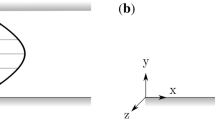Abstract
In our earlier work we have shown the relevance of stability theory in understanding the sustenance of turbulence in turbulent boundary layers. Here we adopt the same model to study the evolution of organised disturbances in turbulent channel flow. Since the dominant modes are wall modes we find that the stability characteristics in the two flows are nearly identical although the boundary conditions (at the edge of the boundary layer and at the centre of the channel) are different. Comparisons with the experiments of Hussain and Reynolds are also presented.
Similar content being viewed by others
References
Craik A D D 1971 Non-linear resonant instability in boundary layers.J. Fluid Mech. 50: 393–413
Gaster M, Kit E, Wygnanski I 1985 Large-scale structures in a forced turbulent mixing layer.J. Fluid Mech. 150: 23–39
Hussain A K M F, Reynolds W C 1970 The mechanics of an organised wave in turbulent shear flow.J. Fluid Mech. 41: 241–258
Hussain A K M F, Reynolds W C 1972 The mechanics of an organised wave in turbulent shear flow. Part 2. Experimental results.J. Fluid Mech. 54: 241–261
Hussain A K M F, Reynolds W C 1975 Measurements in fully developed turbulent channel flow.J. Fluids Eng. 97: 568–578
Klebanoff P S 1954 Characteristics of turbulence in a boundary-layer with zero pressure gradient. NACA technical report No. 3178
Liu J T C 1988 Contributions to the understanding of large-scale coherent structures in developing free turbulent shear flows.Adv. Appl. Mech. 26: 183–309
Malkus W V R 1956 Outline of a theory of turbulent shear flow.J. Fluid Mech. 1: 521–539
Pope S B 1975 A more general effective viscosity hypothesis.J. Fluid Mech. 72: 331–340
Reynolds W C, Hussain A K M F 1972 The mechanics of an organized disturbance in turbulent shear flow. Part 3. Theoretical models and comparisons with experiments.J. Fluid Mech. 54: 263–288
Reynolds W C, Tiederman W G 1967 Stability of turbulent channel flow, with application to Malkus’s theory.J. Fluid Mech. 27: 253–272
Roshko A 1992 Instability and turbulence in shear flows.Theoretical and applied mechanics (eds) S R Bodner, J Singer, A Solan, Z Hussain (New York: Elsevier Science)
Sen P K 1993 Some recent developments in the theory of boundary layer instability.Sādhanā 18: 387–403
Sen P K, Vashist T K 1989 On the nonlinear stability of boundary-layer flow over a flat plate.Proc. R. Soc. London A424: 81–92
Sen P K, Veeravalli S V 1994 Hydrodynamic stability theory applied to wall turbulence.Proc. 21st National Conference on Fluid Mechanics and Fluid Power, Osmania University, Hyderabad, pp TF1 to TF6
Sen P K, Veeravalli S V 1998 On the behaviour of organised disturbances in a turbulent boundary layer.Sādhanā 23: 167–193
Spalart P R 1988 Direct numerical simulation of a turbulent boundary layer up toR θ = 1410.J. Fluid Mech. 187: 61–98
Tennekes H, Lumley J L 1972A first course in turbulence (Cambridge, MA: MIT Press)
Usher J R, Craik ADD 1975 Nonlinear wave interactions in shear flows. Part 2. Third-order theory.J. Fluid. Mech. 70: 437–461
Author information
Authors and Affiliations
Rights and permissions
About this article
Cite this article
Sen, P.K., Veeravalli, S.V. Behaviour of organised disturbances in fully developed turbulent channel flow. Sadhana 25, 423–437 (2000). https://doi.org/10.1007/BF02703624
Received:
Revised:
Issue Date:
DOI: https://doi.org/10.1007/BF02703624




